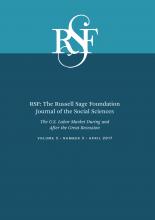Research ArticleII. Social Consequences of the Great Recession
Open Access
Labor Unions and the Great Recession
Ruth Milkman, Stephanie Luce
RSF: The Russell Sage Foundation Journal of the Social Sciences April 2017, 3 (3) 145-165; DOI: https://doi.org/10.7758/RSF.2017.3.3.07
Ruth Milkman
aDistinguished professor of sociology at the City University of New York Graduate Center and research director of CUNY’s Murphy Institute
Stephanie Luce
bProfessor of sociology at the City University of New York Graduate Center and professor of labor studies at CUNY’s Murphy Institute

REFERENCES
- ↵
- Ashenfelter, Orley, and
- John H. Pencavel
- ↵
- Bernstein, Irving
- ↵
- Brady, David,
- Regina S. Baker, , and
- Ryan Finnigan
- ↵Bronfenbrenner, Kate. 2009. No Holds Barred: The Intensification of Employer Opposition to Organizing. Briefing Paper No. 235. Washington, D.C.: Economic Policy Institute.
- ↵
- Burawoy, Michael
- ↵Bureau of Labor Statistics. 2016a. “Union Members—2015.” Washington: Bureau of Labor Statistics. Available at: http://www.bls.gov/news.release/pdf/union2.pdf; accessed March 5, 2016.
- ↵Bureau of Labor Statistics. 2016b. “Major Work Stoppages in 2015.” Washington: Bureau of Labor Statistics. Available at: http://www.bls.gov/news.release/wkstp.nr0.htm; accessed March 5, 2016.
- ↵
- ↵Cohen, Patricia. 2015. “Public Sector Jobs Vanish, Hitting Blacks Hard.” New York Times, May 25, p. A1.
- ↵Commons, John R., and associates. 1918. History of Labor in the United States. 4 vols. New York: Macmillan.
- ↵Cooper, David. 2014. “20 States Raise Their Minimum Wages While the Federal Minimum Continues to Erode.” Economic Policy Institute, Working Economics Blog, December 18. Available at: http://www.epi.org/blog/20-states-raise-their-minimum-wages-while-the-federal-minimum-continues-to-erode/; accessed March 1, 2016.
- ↵Davey, Monica. 2015. “G.O.P. Expands Labor Battle to Laws Setting Construction Wages.” New York Times, May 3, p. 17.
- ↵Dunlop, John T. 1948. “The Development of Labor Organization: A Theoretical Framework.” In Insights into Labor Issues, edited by Richard A. Lester and Joseph Shister. New York: Macmillan.
- ↵
- Evans, Peter
- ↵Farber, Henry. 2014. “Union Organizing Decisions in a Deteriorating Environment: The Composition of Representation Elections and the Decline in Turnout.” IZA Discussion Paper No. 7964. Bonn, Germany: Institute for the Study of Labor. Available at: http://www.econstor.eu/bitstream/10419/93364/1/dp7964.pdf; accessed August 31, 2016.
- ↵Fine, Janice. 2006. Worker Centers: Organizing Communities at the Edge of the Dream. Ithaca, N.Y.: Cornell University Press.
- ↵
- Fine, Janice
- ↵
- ↵
- Fine, Janice
- ↵Flanagan, Maureen A. 2002. Seeing with Their Hearts: Chicago Women and the Vision of the Good City, 1871–1933. Princeton, N.J.: Princeton University Press.
- Hirsch, Barry T., and David A. Macpherson. 2012. Union Membership and Earnings Data Book: Compilations from the Current Population Survey. Arlington, Va.: Bureau of National Affairs.
- ↵Hirsch, Barry T., and David A. Macpherson. 2015. Union Membership and Earnings Data Book: Compilations from the Current Population Survey. Arlington, Va.: Bureau of National Affairs.
- ↵Lafer, Gordon. 2013. The Legislative Attack on American Wages and Labor Standards, 2011–2012. EPI Briefing Paper No. 364. Washington, D.C.: Economic Policy Institute.
- ↵Laird, Jennifer. 2015. “Still an Equal Opportunity Employer? Public Sector Employment Inequality After the Great Recession.” Paper presented at the Population Association of America’s 2015 Annual Meeting. San Diego (April 30, 2015).
- ↵
- Liebman, Wilma
- ↵
- Logan, John
- ↵
- Luce, Stephanie
- ↵
- ↵Mayer, Gerald. 2004. “Union Membership Trends in the United States.” Report. Washington: Congressional Research Service, August 31. Available at: http://digitalcommons.ilr.cornell.edu/cgi/viewcontent.cgi?article=1176&context=key_workplace; accessed August 8, 2016.
- ↵Milkman, Ruth. 2006. L.A. Story: Immigrant Workers and the Future of the U.S. Labor Movement. New York: Russell Sage Foundation.
- ↵
- ↵Milkman, Ruth, and Eileen Appelbaum. 2013. Unfinished Business: Paid Family Leave in California and the Future of U.S. Work-Family Policy. Ithaca, N.Y.: Cornell University Press.
- Milkman, Ruth, and Stephanie Luce. 2015. “State of the Unions 2015: A Profile of Organized Labor in New York City, New York State, and the United States.” New York: City University of New York, Murphy Institute. Available at: http://media.wix.com/ugd/90d188_91d7cdc3f75740909eef83a22cee9cdb.pdf; accessed August 8, 2106.
- ↵Narro, Victor. 2013. “Perspectives: Worker Centers and the AFL-CIO National Convention.” Law at the Margins (blog), September 3. Available at: http://lawatthemargins.com/perspectives-worker-centers-and-the-afl-cio-national-convention/; accessed September 1, 2016.
- ↵National Governors’ Association and National Association of State Budget Officers. 2010. “The Fiscal Survey of States: An Update of State Fiscal Conditions Spring 2010 and Fall 2010.” Available at: http://www.nasbo.org/publications-data/fiscal-survey-of-the-states/archives; accessed September 1, 2016.
- ↵Polanyi, Karl. 1944. The Great Transformation. Boston: Beacon Press.
- ↵Reich, Michael, Ken Jacobs, and Miranda Dietz, eds., 2014. When Mandates Work: Raising Labor Standards at the Local Level. Berkeley: University of California Press.
- ↵Rhomberg, Chris. 2012. The Broken Table: The Detroit Newspaper Strike and the State of American Labor. New York: Russell Sage Foundation.
- ↵Saad, Lydia. 2015. “Americans’ Support for Labor Unions Continues to Recover.” August 17. Gallup (website). Available at: http://www.gallup.com/poll/184622/americans-support-labor-unions-continues-recover.aspx; accessed September 1, 2016.
- ↵Scheiber, Noam. 2015. “Obama Aids U.S. Workers in Late Push.” New York Times, September 1, p. A1.
- ↵
- Schnabel, Claus
- ↵Silver, Beverly. 2003. Forces of Labor: Workers’ Movements and Globalization Since 1870. New York: Cambridge University Press.
- ↵
- Slater, Joseph
- ↵
- Stepina, Lee P., and
- Jack Fiorito
- ↵Stromquist, Sheldon. 2006. Reinventing “The People”: The Progressive Movement, the Class Problem, and the Origins of Modern Liberalism. Urbana: University of Illinois Press.
- ↵Surowiecki, James. 2011. “State of the Unions,” New Yorker, January 17.
- ↵Western, Bruce. 1997. Between Class and Market: Postwar Unionization in the Capitalist Democracies. Princeton, N.J.: Princeton University Press.
- ↵
- Western, Bruce, and
- Jake Rosenfeld
In this issue
Labor Unions and the Great Recession
Ruth Milkman, Stephanie Luce
RSF: The Russell Sage Foundation Journal of the Social Sciences Apr 2017, 3 (3) 145-165; DOI: 10.7758/RSF.2017.3.3.07
Jump to section
Related Articles
- No related articles found.
Cited By...
- No citing articles found.





